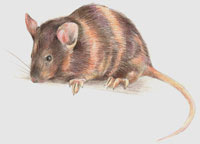Ethics in research Understand article
Is it acceptable to use human embryonic stem cells in research? What about live animals? Professor Nadia Rosenthal, head of the European Molecular Biology Laboratory in Monterotondo, Italy, talks to Russ Hodge about the ethics of her research.
How did your interest in science develop?

Image courtesy of Alan Sawyer
As a teenager, I thought I would become an artist. My parents worked in the theatre and were musicians, and it seemed natural. Nonetheless, I was drawn to the life sciences, especially after an excellent course in advanced biology. Our teacher had a very uncompromising attitude towards her students: she didn’t think that we should be treated like kids. She taught us as if we were at university already, so we learnt about intermediary metabolism, phylogenetic trees and other topics that interested her.
I was fascinated by the crystalline quality of knowledge in biochemistry. My particular interesting was in pattern formation – in developing organisms and across phyla – and I figured that it would have a similarly crystalline explanation, if only I could find the right textbooks. So I arrived at university convinced that within a few years, I would have the whole explanation of pattern formation. Little did I realise that it would take another 25 years – and in fact we are still working on it.
By the time I realised that the explanation would take much longer to find, I was hooked by science and couldn’t imagine any other profession. I had become particularly interested in developmental biology, after reading an article about how limbs are formed. It seemed that there was very little known about limb formation, but I was fascinated by the problem, which seemed to encapsulate my interest in pattern formation.
Some animals are able to regenerate limbs, but mammals aren’t good at that, at least as adults. Why is that?

Image courtesy of Nadia
Rosenthal
We don’t really know. Lower vertebrates can regenerate whole limbs, fins and tails – even jaws and parts of their hearts if they are injured. In contrast, we can’t regenerate much more than a fingernail. The current explanation is that all organisms have some fundamental capacity to regenerate, but that in higher vertebrates, regeneration is prevented by scar formation. If your finger is cut off, you have to close the wound very rapidly. Our immune system launches a massive inflammatory response to keep out infections; this only produces a very useful scar, which stops the bleeding and prevents the wound from getting infected, but also physically blocks the regeneration of the missing limb.
In contrast, a salamander forms a large group of cells called a blastema, capable of developing into just about any part of the limb. The amazing thing is that the cells in the limb appear to know where they are: if the salamander’s limb is cut off close to the body, the blastema regenerates the entire limb. Instead, if the salamander loses its limb at the wrist, the blastema makes just the hand and the fingers. There are theories that gradients of certain molecules are higher at the proximal end of a limb (close to the body) and lower at the distalend, and that these gradients tell the cells which part of the limb they are in. More and more of these molecules are now being investigated in animals such as newts and fish; with the advent of high-throughput sequencing, we may be able to learn what is different about these organisms at the genomic level and maybe even why we can’t regenerate our limbs.
Of course, it’s not only limbs that regenerate. Studying fish, scientists are also learning more about the molecules that guide their heart regeneration and have recently identified factors that are also present in mammalian hearts. When some these factors are introduced into injured mouse heart, they appear to improve wound healing, which is very exciting, but it’s early days. I say that with great disappointment, because I am approximately 30 years older than I was when I first answered this question. And the answers I’m giving you now are only sophisticated versions of the answers I read in the article that got me involved in this topic in the first place. It’s a mystery.
To understand tissue regeneration in mammals, you have worked with stem cells. Could you explain the connection?
The kind of stem cells involved in regeneration are, of course, adult stem cells: stem cells used to replenish the tissues in the adult body when we are injured or diseased, or as we age. In particular, we look at stem cells in mouse skeletal muscle, as these cells have a high capacity to regenerate muscle tissue, even if they cannot regenerate an entire limb.
In contrast, the blastemal cells in the salamander and other lower vertebrates are pluripotent: they have the capacity to make all sorts of tissues. Paradoxically, those blastemal cells appear to come, at least in part, from the de-differentiation of skeletal muscle itself. This involves a much more dramatic reprogramming than we see in the stem-cell pool of mouse muscle.
Adult stem cells don’t seem to cause an ethical debate. But the topic of stem cells generally has raised a lot of ethical concerns.
One area of ethical concern that does overlap with our studies on adult stem cells is reprogramming, which allows embryonic stem cells to generate virtually all the tissues in the body. We try to reprogramme adult mammalian stem cells to behave more like youthful pluripotent cells – in their ability to regenerate a wider range of tissues. Some of that programming has been moderately successful, but in general, adult stem cells do not have as efficient a reprogramming capacity as embryonic stem cells – at least in mammals.
The ultimate embryonic stem cell is of course the fertilised egg, which turns into a whole organism and is thus the source of every single tissue type and every cell type in the body. Scientists have shown that the environment of the egg can reprogramme even a fully differentiated adult nucleus to be pluripotent. This is the basis of therapeutic cloning, if the adult nucleus introduced into the egg comes from a patient. The resulting embryonic stem cells can participate in the generation of virtually any tissue type as the new ‘personalised’ reprogrammed egg divides. To better understand this process, we use mouse embryonic stem cells, harvesting embryos and destroying them to make stem cells. Translating this into a human scenario – harvesting human embryos and destroying them in the process of making what might be therapeutically very valuable stem cells – would cause a great deal of concern.
However, human embryonic stem cells are not identical to mouse embryonic stem cells in their function, gene expression patterns or capacity to be reprogrammed. This means that without studying human embryonic stem cells, we will never be able to reprogramme adult stem cells in humans – which would enable us to use them more extensively in research and thus avoid the prickly issue of human embryonic research. We have got to bite the bullet and decide how best to monitor research on embryonic cells from humans. We certainly don’t seem to have an ethical problem with in vitro fertilisation (IVF), which requires the sacrifice of many human embryos, since only a few of the embryos harvested from a woman having IVF are actually ever implanted. The rest of these embryos are often discarded. Why, then, is there such resistance to the idea of using those otherwise unused cells for research that could benefit humans?
You have worked for a long time with animals, which also raises ethical issues. How do you feel about that?

Image courtesy of Nadia
Rosenthal
I have chosen to study animals, which means that I have to work with animals. We have chosen the mouse for a number of reasons. It’s got a very rapid gestation period and comes to sexual maturity very rapidly, so that we can work on many generations of mice within a short time. Also, we have learnt over the years to manipulate the mouse genome to recapitulate some of the genetic disorders we see in humans; this helps us learn how best to treat mice and thus develop therapeutic strategies for that same disease in humans.
But I have to admit to the fact that I’m very deeply tied to my organism of study: I am a mouse fancier. I believe that the more you understand your organism, the better you can understand what happens when you perturb or manipulate it.
Much of my work has actually made mouse life better: we tended to focus on making mice even better than normal mice. Mice that live longer, mice that are stronger, mice that can have heart attacks and regenerate their hearts. In general, it’s a little bit easier from an ethical point of view to make a mouse healthier rather than to make it ill. Nevertheless, I can’t hide the fact that many of the changes we make render them less healthy than a normal mouse. We also have to sacrifice mice, so that we can study their tissues and organs. Of course, we keep and sacrifice our animals in a very humane fashion: they certainly suffer less than any animal in an abattoir suffers when it is killed for food.
Nonetheless, there is a definite ethical issue, which is whether we can justify using and then sacrificing animals for research, when we are aware that without this research these animals would never exist and would never be manipulated in these ways. It’s a very complicated issue. I find it to be, if anything, more complicated than the embryonic stem-cell issue because embryonic stem cells are not human beings, they are cells. An embryonic mouse stem cell doesn’t elicit the same ethical concerns in me as killing a live animal, a mouse, does.
This is one of the reasons that I have become involved in many large European-based mouse research projects: so that we can use animals as efficiently as possible. We do this by making sure that all European mouse research conforms to single health and handling standards, and that we make only one version of a particular mutation, then all use it and share our information. This enables us to get more data from fewer animals, limiting the number of animals we need to raise, observe and then kill. Minimising the number of animals used and minimising their suffering is probably the most ethical thing we can do.
Send us your suggestions
We welcome your suggestions for future feature articles for Science in School. Which scientists in your home countries do you find particularly interesting? Why? What is their area of research? If possible, please include their contact details. Send your suggestions to editor@scienceinschool.org
References
- Nadia Rosenthal was one of two stem-cell researchers to deliver the 2006 Howard Hughes Holiday Lectures on Science for high-school students. The lectures are available online and the DVD can be ordered on the website of the Howard Hughes Medical Institute: www.hhmi.org/lectures





